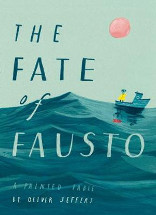The fate of Fausto: a painted fable by Oliver Jeffers

HarperCollins Children's Books, 2019. ISBN: 9780008357917.
(All ages). Highly recommended. Themes: Greed, Wants and needs.
Fausto wants everything to bow in acknowledgement to him. He
believes that he owns everything and goes to a flower, a sheep, a
tree, a field, forest and a lake to force their submission to him.
He expects this, although the lake takes some time to see things his
way. Next the mountain holds his ground, making the man make his
fist, stomp his feet and generally put up a fight. The mountain
concedes.
Children and adults alike will see parallels all around them of
behaviour such as this.
But the man is still dissatisfied and takes to a boat upon the sea.
Away from the shore he tells the sea that the sea belongs to him.
The sea remains silent. He tells the sea again that he is its owner,
and this time the sea responds, telling him that Fausto does not
owns the sea. He is adamant that he does and says he will stamp his
feet, and climbs out of the boat onto the sea to do so. He
disappears.
None of the things that bowed to him cared. They carried on just as
before. Fausto's fate did not matter to them at all.
A wonderful modern fable about possessions and self image, readers
of all ages will thrill at the behaviour shown by Fausto in trying
to get his own way, seeing parallels in the nightly news or history
or people with whom they mix.
This story reveals all the elements of a fable, a short story in
which animals have human characteristics and ends with a moral, and
will be another discussion point with students. Comparing this tale
with Aesop's fables, for example will widen the student's literary
vocabulary and enable them to see other examples of modern fables.
Students could discuss why the author has chosen the name Fausto for
his anti hero, and absorb the wonderful story retold by Kurt
Vonnegut at the end of the book, seeing parallels between that story
and why Jeffers wrote his fable.
The startling illustrations done using a lithographic printmaking
technique, add to the dream like qualities of the story as many
pages are blank,some pages have a phrase and just a line of colour,
some pages are covered with colour but all expect the reader to
think about what is happening, to think about the man's expectations
of life and his dissatisfaction with what he has ending with his
sinking into the sea and oblivion.
The endpapers reflect books from years ago with their wonderful
marbling effect and intricate designs, which once more will attract
the readers to look again before the book is closed.
Fran Knight